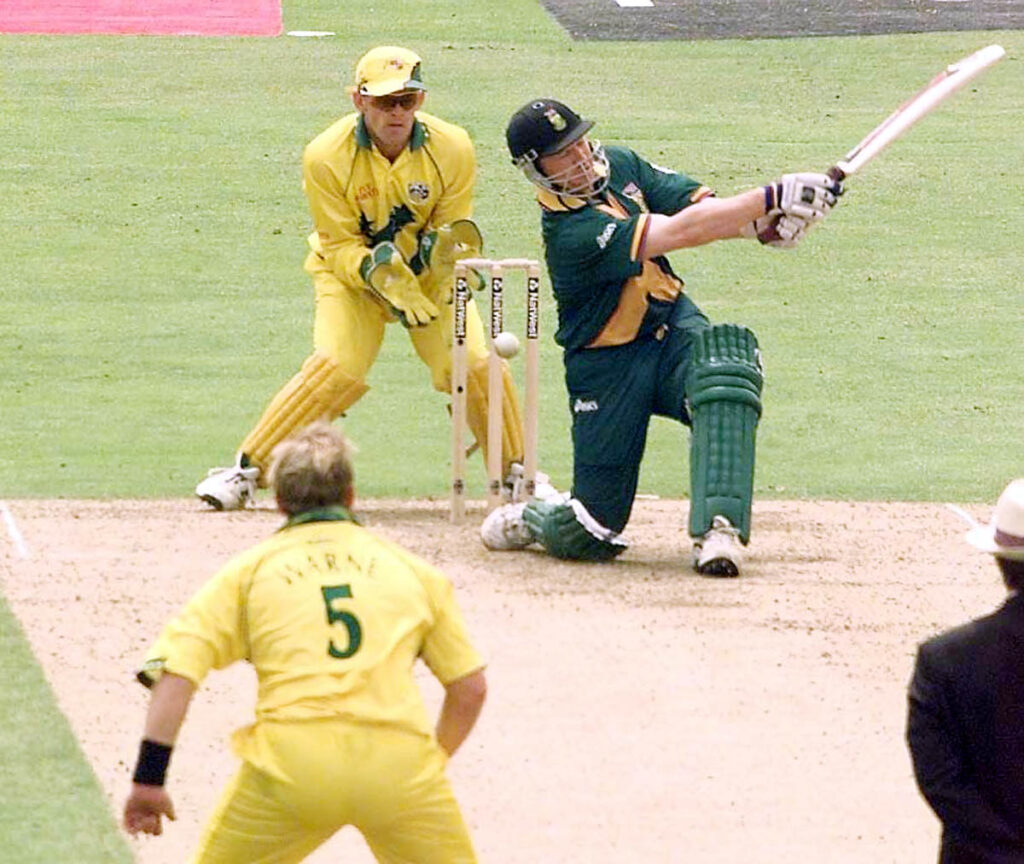Shane Warne of Australia celebrates taking the wicket of Mike Gatting with the Ball of the Century. (Photo by Rui Vieira/EMPICS via Getty Images)
It’s easy to imagine: there Shane Warne stands, at the top of his mark, casually tossing the ball from hand to hand. Standing at his crease on the other side of the pitch is the batsman, trying to strike a balance between being unperturbed and frightened shitless.
With Warne there was much to be anxious about. He had an array of deliveries that all looked the same. The orthodox, big-ripping leg-spinner, the flipper, the arm-ball, the top-spinner, the googly, so you never knew quite what he was about to pull from his bag of tricks. Although you outwardly projected calm, you never really knew.
Think of poor Mike Gatting, the England skipper and once a Rebel Tourist, prodding his pad out to a ball that appeared to be sliding down the leg-side only to find it gripping, twisting with sinister zip and spin — a kind of taboo delivery, at war with all the known laws of physics — to knock the top of his off-stump. It was so shattering, so inexplicable, it was dubbed the “Ball of the Century”.
“Thanks Gatt, mate, thanks for coming.”
Before Warne there were cavaliers like the Australian all-rounder, Keith Miller, who flew Mosquitos during World War II and toured England with “The Invincibles”, the famous 1948 Australians. Miller sometimes arrived at the ground of an irrelevant county game still dressed in his black dress suit after a night of dancing and fun. “What’s pressure? That’s having a Messerschmitt 109 up your ass,” he said.
Ian Botham, England’s barnstorming all-rounder in the Miller mould, was similarly free-spirited, but neither had Warne’s sharp talent for making the game his. No cricketer before or since has had such wide-ranging demand of the dramatics, of the emotional and existential possibilities of making people sweat.
And he had a mouth on him, too. “What colour’s the couch, Daryll,” Warne famously quipped to Daryll Cullinan when he found out that the South Africa batsman had been consulting a sports’ psychologist.
 Australia’s Shane Warne bowls out Darryl Cullinan of South Africa, during their Cricket World Cup Super Six Match at Headingley. (Photo by John Giles – PA Images/PA Images via Getty Images)
Australia’s Shane Warne bowls out Darryl Cullinan of South Africa, during their Cricket World Cup Super Six Match at Headingley. (Photo by John Giles – PA Images/PA Images via Getty Images)
Warne used to limp around the notoriously injury-prone New Zealand all-rounder, Chris Cairns, and called the England skipper, Nasser Hussain, “Saddam”.
He even nicknamed Brian McMillan, the South-African all-rounder “Depardieu”, after the French actor, Gerald Depardieu, to whom McMillan bore a striking resemblance.
As well as the timing, the amateur dramatics and the lip, Warne had a famously strong upper body. A childhood illness meant he needed to drag himself around on a kind of home-made trolley because he couldn’t walk, and it developed his shoulders and chest. His hands were big pudding-like things and his fingers were strong. He could bowl for a long time, so if he didn’t get you out immediately, he’d wear you down.
Warne was talented as a young man, but he trained poorly and ate badly. He was inclined to put on the pounds. He wanted to be an Aussie rules footballer but when that dream hit a brick wall he looked to cricket.
The former Aussie leg-spinner, Terry Jenner, took him under his wing and tried to channel the boisterousness and bad-behaviour. They call them larrikins in Australia and until late in life — possibly until the end in Thailand where he died of a suspected heart attack on Friday — Warne had a bit of the larrikin in him.
But Jenner saw something. He persisted with the kid, who went to the Australian Academy in Adelaide. And, then, because the Aussies are more adventurous than most, Warne made his Test debut. There was a long and industrious tradition of Aussie leggies — Clarrie Grimmett, Richie Benaud, Kerry O’Keefee — to backup their choice. The boy would be fine.
He wasn’t. He made his debut at the Sydney Cricket Ground against India in 1992 and India only batted once for 483 in a drawn game. Warne’s figures? One for 150 in 45 expensive overs. Ravi Shastri (with whom he shared the commentary box occasionally in the years after) took him to the cleaners, scoring 206. Warne had the last laugh, getting Shastri out, but was promptly dropped. And he wore a yellow Speedo beneath his whites. The crusty old codgers in the members’ pavilion wished him good riddance and bid him goodbye.
But Warne was too strong, too artful, and too gifted for that. Despite flirtations with drugs (he was sent home from the 2003 World Cup here in South Africa after admitting to taking diuretics) he bounced back from his India Test debut, going on to take a remarkable 708 wickets in 145 Test matches, gobbling a further 293 ODI wickets in 194 ODIs.
He was part of an Australian side of extravagant riches, initially starting out under Allan Border but playing under Mark Taylor, Steve Waugh and Ricky Ponting. He finished off where he started out, at the Sydney Cricket Ground, 16 years later, taking two expensive England wickets in an undistinguished display. It didn’t matter. By then everyone knew who Warne was. That’s what bowling the Ball of the Century does for you.